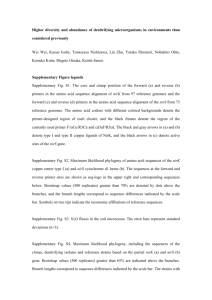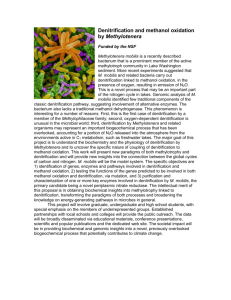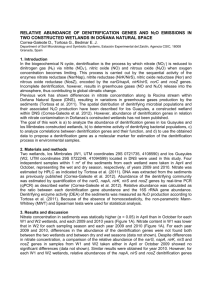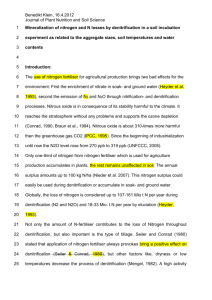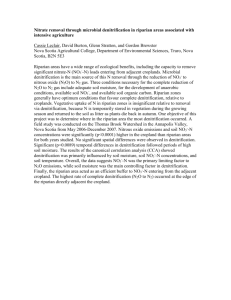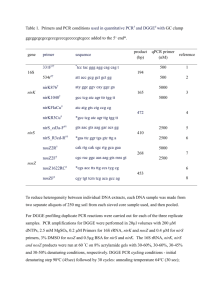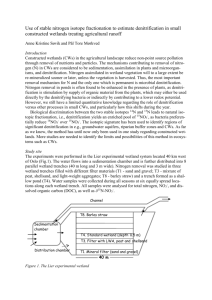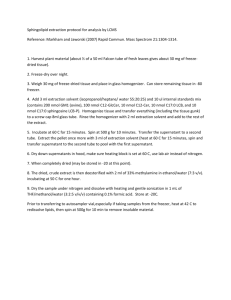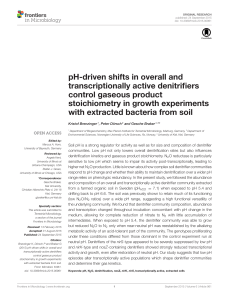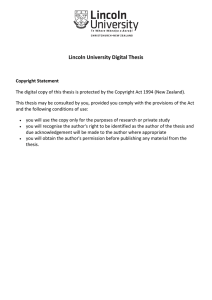nirK - Auburn University Environmental Institute
advertisement
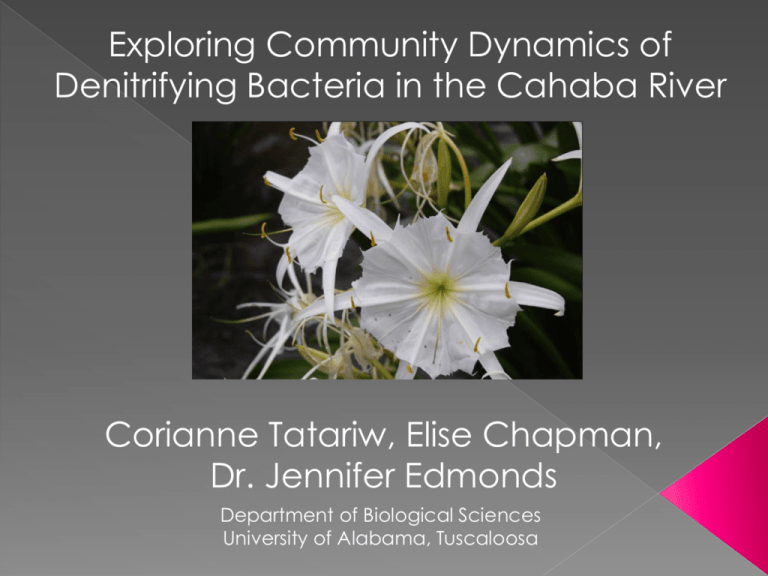
Exploring Community Dynamics of Denitrifying Bacteria in the Cahaba River Corianne Tatariw, Elise Chapman, Dr. Jennifer Edmonds Department of Biological Sciences University of Alabama, Tuscaloosa Acidification/ eutrophication of freshwater systems Loss of biodiversity Images from NOAA •Harmful algal blooms •Eutrophication/ hypoxia in coastal systems Goal: evaluate denitrification as a meaningful nitrate sink in large rivers How does denitrifier community structure respond to environmental parameters? What is the effect of these changes in denitrifier community structure on rates of denitrification? High diversity of microorganisms suggests functional redundancy, but… Denitrifier communities respond differently to environmental conditions, affecting rates of denitrification (Cavigelli and Robertson 2000) NO3- NO2- NO nirS /nirK N2O N2 gas Heterotrophic facultative anaerobes Dissolved Oxygen (DO) affects distribution of nirS and nirK denitrifiers (Graham et al 2010, Knapp et al 2009) › nirK denitrifiers can function under fluctuating DO conditions › nirS denitrifiers found in consistently anoxic environments Measured as porosity: Fraction of void space in a volume of sediment Greater surface area: volume in smaller sediments Affects movement of DO through sediment VR FL CP Valley Ridge (VR) Fall Line (FL) Coastal Plain (CP) 2 P- C 1 P- C FL -2 FL -1 -2 VR -1 VR Porosity 0.8 0.6 0.4 0.2 -2 -1 P2 C P1 C FL FL -2 VR -1 VR SRP (ppb) C C 2 P- 1 P- 2 FL - 1 FL - -2 VR -1 VR NO3-N (ppb) Birmingham 3000 2500 2000 1500 1000 500 0 350 300 250 200 150 100 50 0 NirS and nirK denitrifiers will have distinct community structures within each geophysical province due to changes in sediment size and channel slope. Dominance of nirS vs. nirK will vary due to spatial and seasonal variations in DO Three subsamples taken from homogenized sediment in field › Spring, Early Summer, Late Summer, Winter › 2 locations per geophysical province (VR, FL, CP) TRFLP of nirS and nirK › nirS: cd3aF/R3cd-HEX › nirK: FlaCu-FAM/R3Cu › Restriction enzyme: MspI Analysis of Similarity: Primer v.6 2D Graph 2 No significant difference by geophysical province or date nirS dominates in anoxic environments which may have less variable conditions 2D Stress = 0.14 Valley Ridge X Fall vs Y - CP Line X vs Y - FL Coastal Plain X vs Y - VR Global R = 0.157 p = 0.03 nirS Coastal Plain different from Valley Ridge and Fall Line No significant seasonal difference CP has finer, sandy substrate compared to VR and FL 2D Stress = 0.22 Valley Coastal PlainRidge Fall LineLine Fall Valley Ridge Coastal Plain Global R = 0.223 p = 0.001 Denitrification rates will vary among geophysical provinces in response to changes in denitrifier community composition. Highest rates of denitrification will coincide with high primary productivity as carbon limitation is alleviated Sediment samples collected with microbial samples Acetylene block method to measure denitrification potential rates 5 0 5 0 5 0 Denitrification Rate (mmol N2 g-1 hr-1) Denitrification Potential Rate (nmol/g/hr) 0 p <0.05 b 30 25 ab 20 ab 15 10 a 5 VR FL CP 0 Spring Early Summer Late Summer Winter VR Apr Amb Jun Amb Sept Amb FL CP The Cahaba River is a sink for NO3- Lack of relationship between changes in community composition and denitrification rates suggests functional redundancy Committee Members Dr. Jennifer Edmonds Dr. Robert Findlay Dr. Lisa Davis Lab Members Elise Chapman Courtney Dragiff Susan Jozefiak Ben Wilson Field and Lab Help Chau Tran Julie Jarnigan Diane Schneider Marie Wilson 2D Stress = 0.16 • Bacterial community structure changes over time through macrophyte growing season 2 June 2010 14 July 2010 24 June 2010 2 June 2010 2 June 20102010 24 June 24 June 2010 14 July 2010 14 July 2010 Global R = 0.414 p = 0.001 VR DNP (nmol N2 g-1 hr1) 20 * Dec. 2010 Ambient 500 M N 500 M N/ 2500 M C 15 10 16 5 14 0 VR 12 FL CP 10 6 4 2 0 VR * Statistically significantly different from ambient denitrification potential rate; p=0.05 DNP (nmol N2 g-1 hr1) 8 Apr. 2011 FL CP Fall Line Estimated deposition of reactive nitrogen in a) 1890s and b) 1990s • Fertilizer • Leguminous crops • Livestock • Fossil fuel combustion Galloway et al. 2004. Biogeochemistry 70: Burgin and Hamilton. 2007. Front Ecol. Environ. 5: 8996 nirS: Consistently anoxic environments, always active nirK: Areas of DO flux, more active at night Nitrite reductase cytochrome-cd1 Copper-containing nitrite reductase Nurizzo et al. 1998. Biochemistry 37: 1398713996. Nojiri et al. 2007. PNAS. 104: 4315-4320. Denitrification is occurring along the Cahaba at rates comparable to those in literature (Piña-Ochoa and ÁlvarezCobelas 2006) Highest rates occurred at the Fall Line in summer › Lack of C response suggests in-stream primary producers alleviated C-limitation › Spatial heterogeneity at Fall Line Ambient +N (500 M) +N+C (500/2500 M) (nmol(nmol N2O/g/hr) Potential DenitrificationDNP N2 g-1 hr-1) 50 40 30 20 10 0 VR1 VR2 FL1 FL2 Site CP1 CP2 2D Graph 5 Ambient +N (500 M) +N+C (500/2500 M) ** 60 DNP (nmol N2O/g/hr) 50 40 30 20 * * * * 10 0 VR1 VR2 FL1 FL2 Site * Significantly different from ambient DNP rate; p <0.05 CP1 CP2 1) Denitrification potential rate vary in the How do rates of denitrification measurements Cahaba River? in April 2011 will be highest at the Fall Line 2) How does denitrifier community composition change over space and time? 2) T-RFLP of nirS and nirK functional genes will show distinct denitrifier community structure at the scale of geophysical 3) How qPCRdoes of nirS denitrifier and nirKactivity will show and increased province. abundance denitrifier activity change andover abundance space and time? associated with higher denitrification rates and there will be changes in nirS vs. nirK activity over space and time. Date Site Jun 2010 LB HL CV SP MJ 03 Jun 2010 PP 24 Jun 2010 PP 14 Jul 2010 US MB SC DD Aug 2010 PP Sep 2010 PP Sep 2010 LB HL CV SP MJ Dec 14 2010 LB HL PP CV SP MJ Avg Ambient StDev Temperature °C 8.161998949 0.332226 29.2 6.289706525 0.641923 29.5 3.162459464 0.686203 29 4.703626103 3.821566 29 4.994243446 0.058324 18.83327397 7.527388 28.9 26.41588141 3.552288 30.1 6.471659572 1.451805 30.7 4.279251108 1.649617 4.420255345 1.476759 4.165626458 1.037914 8.372572675 3.651942 32.2 11.56170254 12.80802 28.8 5.767593586 1.34986 7.111404042 0.805633 10.28448042 4.559856 5.749148825 0.785916 1.982245124 0.201137 8.917669919 2.055431 4.5 6.862733321 1.916889 6 18.48504912 2.247254 6.1 6.692058788 1.784798 6.893814842 6.023206 6.7 7.50694151 0.692246 6.5 Porosity 0.386133333 0.373494737 0.3837 0.357856642 0.392133333 StDev 0.006886 0.018102 0.014843 0.009515 0.020305 AFDM 2.601236945 2.283198858 1.740152112 0.386379651 0.633802713 StDev 0.377843 0.254031 0.08738 0.085188 0.624277 0.478411111 0.057839 3.764592511 1.411641 0.38225 0.38875 0.382 0.3175 0.37925 0.286 0.2612 0.219333333 0.401066667 0.588266667 0.682933333 3.987856567 2.071134073 1.559518416 0.281233063 0.410048422 3.806077359 2.829575575 4.112442571 2.034080692 3.732548565 3.302282683 0.00916 0.365 0.007104 0.00952 0.030766 0.069527 0.056908 0.032934 0.028381 0.019129 0.026544 0.847384 0.239217 0.12772 0.199009 0.369577 0.235186 0.736192 0.405341 0.6658 1.639047 0.318121 •Large and unregulated •North of Birmingham to Selma, AL •Confluence with Alabama River •Valley Ridge, Fall Line, Coastal Plain How do rates of denitrification vary in Denitrification streams receiving large the Cahaba in River? 1) inputs of NO3 is limited by organic carbon lability. 2) How does denitrifier community • Primary producer distribution will composition change over space and control denitrification longitudinally. time? • Seasonal changes in labile OC availability will affect rates of 3)denitrification. How does denitrifier activity and abundance change over space and time? 5 0 100 200 (nmol N2 g-1 hr-1) Potential Denitrification DNP (nmol N20/g/hr) [ CP-2 December 2010 Coastal Plain Site 2 – Dec 2010 No Carbon Carbon 20 15 10 5 0 100 200 300 400 NO3- Concentration (mmol) [NO3-Added ] No Carbon Carbon 500 No Carbon Carbon FL-2 December 2010 Fall Line Site 2 – Dec 2010 DNP (nmol N20/g/hr) (nmol N2 g-1 Potential Denitrification hr-1) 12 9 6 3 0 100 200 300 400 [NO3-] Added (mmol) NO3- Concentration 500 › -Delivery of NO3- to subsurface influenced by geomorphology (Böhlke et al. 2009) › -Competition with in-stream primary producers Early * Summer VR Fall Line Late Summer DNP (nmol N2 g-1 hr1) 60 40 0 * 50 30 FL Ambient 500 M N 500 M N/ 2500 M C 40 20 30 20 10 No significant response to nitrogen or carbon (p=0.05) 10 00 VR FL1 FL FL2 CP X Data FL1: Middle of Fall Line, macrophyte-dominated shoals 50 Late Summer DNP (nmol N2 g-1 hr1) Col 27 Col 29 Col 31 40 30 F2: Bottom of Fall Line, transition to Coastal Plain * Statistically significantly different from ambient denitrification potential rate; p=0.01, 0.02 20 10 0 VR FL CP
